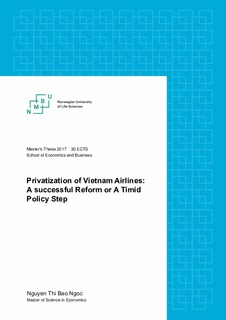| dc.description.abstract | This study provides an overview about the privatization process of the national airlines in Vietnam, representing for a key large SOE which has been privatized. Therefore, it helps to reflect the process of the country in term of the government perspectives in general, through which to bring ideas or suggestion for more efficient policy to favor liberalization.
Privatization of state-owned enterprises (SOEs) is one pillar of the structural reforms in addition to the deregulation and trade liberalization. As a necessity for development, Vietnam implemented privatization along with the Renovation policy to transfer from a centrally planned market to an open and market-oriented economy as a necessity for development. The privatization process in Vietnam is on-going and has begun in large SOEs. The privatization of Vietnam Airlines is a typical case of a large-scale concern undergoing privatization through equitization. This study is of particular interest for the Vietnam Airlines’ privatization in evaluating the success or failure of the equitization.
This study qualitatively analyzes the airline’s performance, and market conditions as competition on the domestic market and the stock exchange using secondary data. Comparison is made with other airlines, e.g. British Airway, Air Canada, LAN Chile and Kenya Airway. The analysis of impacts of the privatization process on the airline performance, which are reflected by the firm’s growth, profitability, productivity was conducted by combining and looking at the changes in the indicators as total assets and its components, profits, sales, debts, profitability ratios, number of workers, and volume of passengers.
The results showed a positive effect of the privatization. That is, the airline improved its performance efficiency, reflected by the increase in all criteria. However, when examining competition under market shares and the stock prices, it seemed that the equitization of Vietnam Airlines failed to become more competitive relative to its rival on the domestic aviation market, and failed to attract investors on the stock exchange. The comparison among Vietnam Airlines and the other national airlines used the comparison table with comparative criteria based on the country and macroeconomy conditions, perspectives of the government on privatization and the way the process was implemented. The analysis showed that Vietnam does not have a good economic environment for the privatization and the government also failed to show a firm commitment to privatize larger-scale SOEs, especially large firms. Therefore, the privatization in Vietnam Airlines has been too slow and fragmented compare to other cases. Hence, combining all the above results tells us that the privatization of Vietnam Airlines seemed not to be considered as a successful case in term of raising the competitiveness and withdrawal of the state’s intervention, even though it may still bring efficiency to the airline. | nb_NO |

